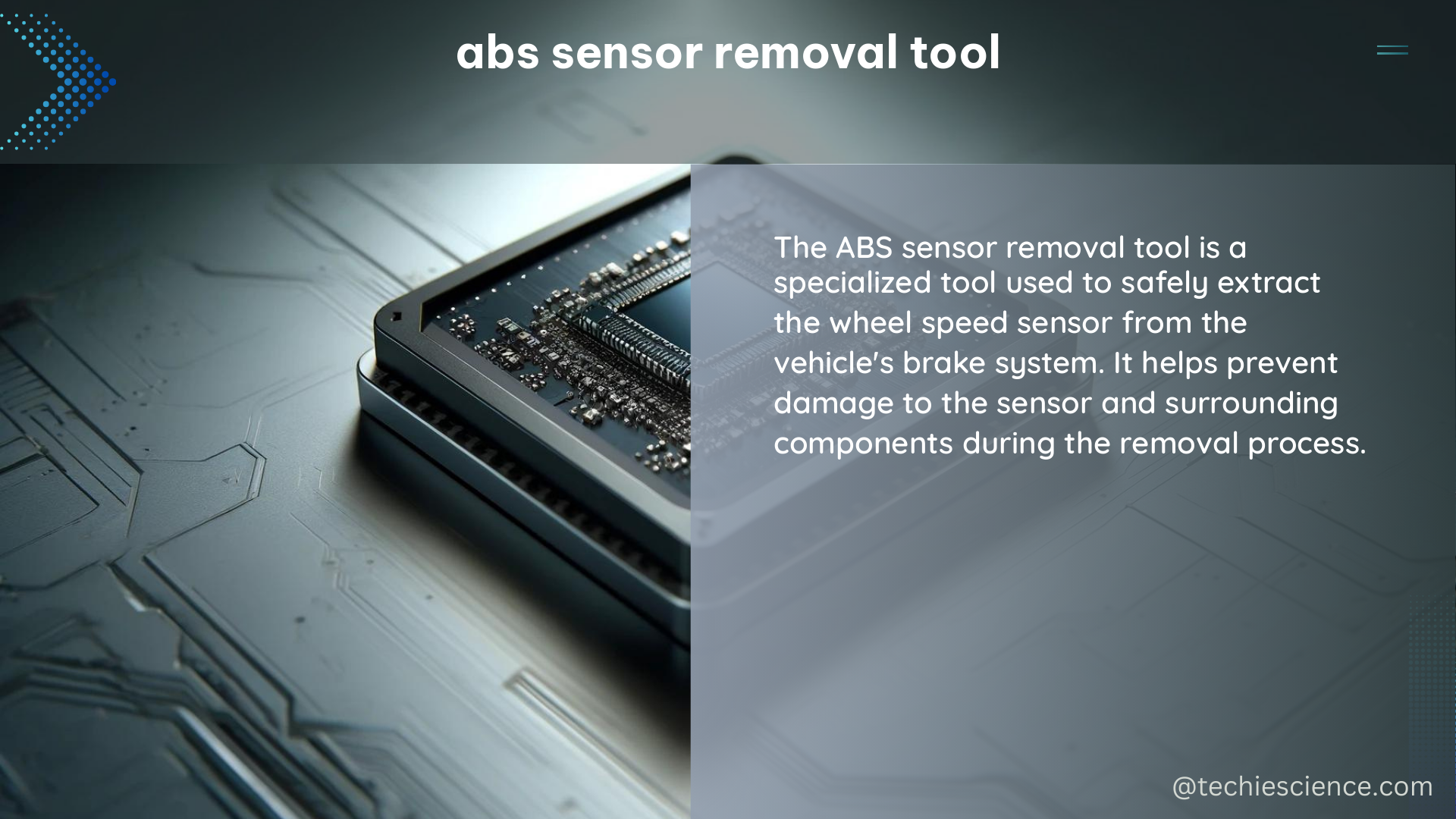The ABS (Anti-lock Braking System) sensor is a critical component in modern vehicles, responsible for measuring the rotational speed of the wheels and providing this information to the ABS control unit. This data is used to detect wheel slip and prevent the wheels from locking up during braking, thereby improving safety and maintaining control of the vehicle. Understanding the proper use of an ABS sensor removal tool is essential for any DIY enthusiast or automotive technician.
Understanding ABS Sensors: Active vs. Passive
ABS sensors can be classified as either active or passive, with each type having its own unique characteristics and requirements. Active sensors require a supply voltage and generate an output signal, while passive sensors operate without additional supply voltage. Inductive-passive sensors, a type of passive sensor, work by positioning the sensor directly above the impulse wheel, which is connected to the wheel hub or drive shaft. The rotation of the impulse wheel causes a change in the magnetic flow, inducing a quantifiable alternating voltage in the winding. The frequency and amplitudes of this alternating voltage are directly related to the wheel speed.
Measuring ABS Sensor Output

Accurately measuring the output of the ABS sensor is crucial for diagnosing and troubleshooting any issues. The most accurate method is to use a scan tool capable of gathering data for the ABS system. This can be done during a road test, providing real-time data on the sensor’s output. For those looking for a more DIY approach, an oscilloscope can be used to visualize the signal from the ABS sensor.
Using an Oscilloscope to Measure ABS Sensor Output
When using an oscilloscope to measure the ABS sensor output, the signal from a 2-wire Hall effect sensor can be observed. The signal will show a 0V reading when the wheel is standing still and a 0.9V signal when the wheel is spinning. To measure the speed, the number of pulses per second can be counted and used to calculate the distance traveled per second, thus the speed in m/s.
Technical Specifications of ABS Sensors
The technical specifications of ABS sensors, particularly inductive-passive sensors, are crucial for understanding their operation and proper installation. The frequency and amplitudes of the alternating voltage induced in the winding of an inductive-passive sensor are directly related to the wheel speed. The gap between the sensor and the impulse wheel is provided by the axle design, ensuring proper operation and signal detection.
Sensor Gap Specifications
The gap between the ABS sensor and the impulse wheel is a critical factor in the sensor’s performance. This gap is typically specified by the vehicle manufacturer and can vary depending on the make, model, and year of the vehicle. It is essential to follow the manufacturer’s recommendations when installing or replacing an ABS sensor to ensure optimal performance and longevity.
| Vehicle Make | Model | Year | Sensor Gap (mm) |
|---|---|---|---|
| Toyota | Camry | 2015-2020 | 0.5 – 1.5 |
| Honda | Civic | 2016-2021 | 0.7 – 1.3 |
| Ford | F-150 | 2018-2022 | 0.4 – 1.0 |
| Chevrolet | Silverado | 2019-2023 | 0.6 – 1.2 |
Removing and Replacing ABS Sensors
Proper removal and replacement of ABS sensors are crucial to ensure the continued reliable operation of the ABS system. Here is a step-by-step guide on how to remove and replace an ABS sensor:
- Locate the ABS sensor: Consult your vehicle’s service manual or repair information to identify the location of the ABS sensor you need to remove.
- Disconnect the sensor connector: Carefully disconnect the electrical connector from the ABS sensor, taking note of the orientation and any locking mechanisms.
- Remove the sensor: Using the appropriate ABS sensor removal tool, gently pry the sensor out of its mounting. Avoid using excessive force, as this can damage the sensor or the surrounding components.
- Clean the sensor mounting area: Use a clean, lint-free cloth to wipe away any dirt, debris, or corrosion from the sensor mounting area.
- Install the new sensor: Carefully insert the new ABS sensor into the mounting location, ensuring that it is properly aligned and seated. Reconnect the electrical connector, making sure it is securely locked in place.
- Verify sensor operation: Use a scan tool or oscilloscope to confirm that the new ABS sensor is functioning correctly and providing the expected output signal.
Conclusion
The ABS sensor is a critical component in modern vehicles, responsible for measuring wheel speed and providing this data to the ABS control unit. Proper use of an ABS sensor removal tool is essential for maintaining and troubleshooting the ABS system. By understanding the technical specifications, measurement techniques, and removal/replacement procedures, DIY enthusiasts and automotive technicians can ensure the continued reliable operation of their vehicle’s ABS system.
References:
- ABS wheel speed sensor – measuring vehicle speed – Arduino Forum, 2012-10-08, https://forum.arduino.cc/t/abs-wheel-speed-sensor-measuring-vehicle-speed/123583
- BRAKE DISCS AND WHEEL SPEED SENSORS IN ABS SYSTEMS, HELLA PAGID, https://www.hella-pagid.com/hellapagid/assets/media/Brake_Disc_ABS_PAGID_EN.pdf
- Check and change ABS and wheel speed sensors – HELLA, https://www.hella.com/techworld/us/Technical/Sensors-and-actuators/Check-change-ABS-sensor-4074/
- Testing ABS Wheel Sensors – iRV2 Forums, 2018-07-09, https://www.irv2.com/forums/f22/testing-abs-wheel-sensors-400349.html
- How to get ABS LIVE DATA from your car in 2 minutes. – YouTube, 2021-03-01, https://www.youtube.com/watch?v=bEXaEL4efKA

The lambdageeks.com Core SME Team is a group of experienced subject matter experts from diverse scientific and technical fields including Physics, Chemistry, Technology,Electronics & Electrical Engineering, Automotive, Mechanical Engineering. Our team collaborates to create high-quality, well-researched articles on a wide range of science and technology topics for the lambdageeks.com website.
All Our Senior SME are having more than 7 Years of experience in the respective fields . They are either Working Industry Professionals or assocaited With different Universities. Refer Our Authors Page to get to know About our Core SMEs.